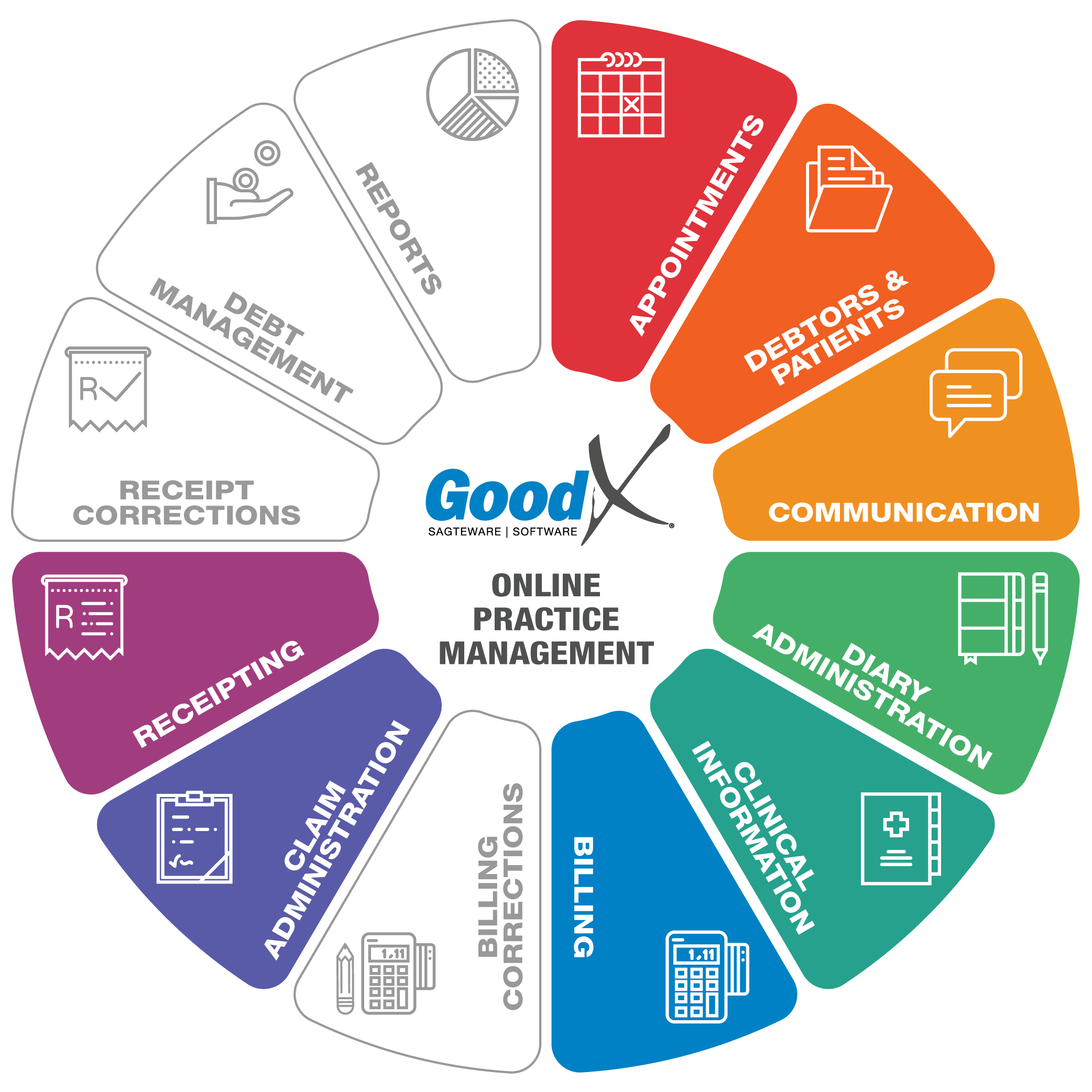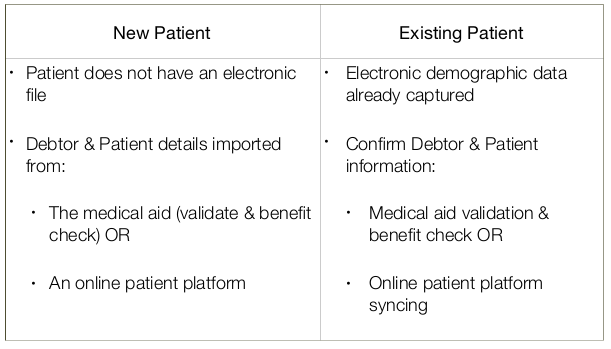Best Practice Guidelines: Telehealth Practice Management

Copyright © 2020 GoodX Software. All rights reserved.
GoodX online Learning Centre
learning.goodx.co.za
5. Pre-consultation phase
5.2. Debtors & Patients
Responsible Roles
|
|
Open electronic files for debtors and patients, upload all required documents, and ensure that the demographic information is captured correctly. Do validations and benefit checks before consultations. Verify demographic information of
debtors and patients. Update debtor files to reflect changes on patients such as dependants that have passed away or moved to their own medical aid. |
 |
The practitioner will have to verify the demographic information of a patient in cases like call-ins where the administration would not have been completed prior to the appointment. |
 Purpose of Debtors & Patients
Purpose of Debtors & Patients
The correct information for:
- Debtor - the person responsible for medical accounts, eg. the main member of the medical aid who also acknowledges liability for medical accounts of their dependants or guardians of minors; and
- Patient - medical aid dependants or private patient dependants; information of patients has to be captured meticulously as they are the people receiving healthcare services, who have medical aid benefits or who are private patients. Document the location of the patient, as his location is the place where medical services are rendered and is therefore of importance in any legal dispute.
All information must be captured so that:
- claim processing will be successful,
- follow-ups can be managed and
- correct clinical records can be created for the right patients.
Time of capturing Patient information:
- Patients requesting appointments:
- Information captured/updated when the appointment is confirmed by Reception;
- A patient requesting call-in consultations:
- Information imported and updated during a consultation by the Practitioner.
All private patients or depleted medical aid funds patients should pay a deposit prior to the Telehealth consultation.
Tasks associated with Debtors and Patients
The practice will always work with 2 different patient types:
- New patient appointments
- Existing patient appointments

New patient appointments
- New patients making appointments don't have electronic files and there is no captured information on the Practitioner's software.
- Send the patient a booking confirmation from the software.
- The appointment will only be a placeholder and the patient's file with the debtor's account will be created when reception confirms the appointment and contacts the Patient for the necessary information.
Import debtor and patient data
The debtor information can be imported from Medical Aid or a patient online platform.
Some Medical Aids allow you to import the Main Member and Dependant information directly from the database of the Medical Aid to create a new Debtor and their dependants. Each medical aid will supply different demographic detail. Most but
not all of the Medical Aids have an import function available.
Certain online patient platforms, for example, myGC, can be used by patients to keep all their demographic information and share this information with practices, who can import the data into their software.
Create new debtor
A Medical Debtor is the person who is responsible for the account, for example;
- The main member of the medical aid;
- Signs an agreement accepting responsibility for the medical account of his or her dependants;
- Any private patient;
- The guardian(s) of any minor patient;
- Any person signing an agreement who accepts responsibility for the medical account on behalf of a patient (guarantor).
Make sure the following demographic information is correct and captured on the system:
- Debtor and patient full names and surname
- ID Numbers of both the Debtor and Patient
- Medical aid name and plan, medical aid number and dependant number
- Contact information of the debtor and patient
With the opening of a patient electronic file, the patient validation and benefits check can be done to see if the patient is active on the medical aid. Some demographic information can be imported from medical aids, depending on the information the medical aids make available for import.
Add dependants
Dependants are the people for whom the medical debtor is responsible for. The main member will be responsible for the account for dependants posted on his or her file.
Confirm that the dependant code correlates to the dependant code listed on the medical aid card to ensure successful claim processing.
Dependants can be children, spouses, stepchildren, or even grandparents.
Debtor and Patient Documents
When a patient has a video appointment, it is necessary to get documentation from the patient in electronic format. All compulsory documents, like consent forms, ID documents, medical aid cards, proof of residence and pre-consultation questionnaires can be requested and the patient can send photos of his or her documents to the practice or for example upload it via the online myGC platform.
Upload all such documents into the software so that it will always be easily accessible to staff who for example need to make sure outstanding accounts are settled.
- Debtor document types: Financial, Personal or Practice documents.
- Patient document types: Medical, Financial, Personal, Practice, Portrait, or Correspondence documents.
- Compulsory documents can be marked as required. The document icon should show red until all necessary documents have been uploaded.
- The debtor and patient ID's and medical aid documents can be scanned and stored in the debtor’s file.
- This will eliminate the cost of printing and filling space and it will always be available in electronic format.
- Ask the patient to upload their medical aid card and ID documents onto a platform like my GrandCentral to be downloaded to the practice databases or email it to the practice.
Examples of documents:
- Informed consent
- ID of the Patient and Debtor
- Birth Certificate for minors
- Medical Aid Card
- Proof of residence
- Questionnaires
Existing patient appointments
- Book an existing patient if the patient's information has already been captured on the system. The patient already has an electronic file at the practice on the system.
- Confirm the patient information telephonically or request the patient to confirm his or her details through a platform like myGrandCentral.
- Patient medical aid validation and benefit checks can also be used.
- Send a booking confirmation to the patient via the system.
Patient validations and benefit checks
Validate all medical aid patient files before the patients consult with the practitioner to ensure that demographic information is up to date. Update any incorrect or outdated information.
Use the benefit check to ensure that there are funds available in the medical savings account. Only three benefit checks are available on each patient file per day. The practice will request the medical aid if a certain amount is available and the system will reply with the availability. The system does not show the amount that is available in the patient’s savings account. Only the amount that the user has requested will be checked.
Make a patient inactive
If dependants get their own medical aids or pass away, they can be marked as inactive on the system. This will ensure that no further correspondence will be sent to those patients. All new notes and/or correspondence will be done on the new patient accounts or electronic files.
Some clinical notes can be copied from the old electronic files to the new electronic files.
